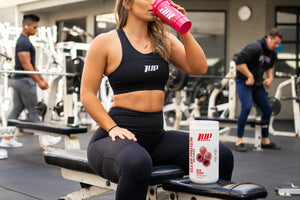There comes a point in every fitness enthusiast’s training career when they hit a plateau and the tried-and-true, bread-and-butter basics stop working (or lead to such minimal gains that it’s imperceptible).
When you hit this wall, just doing the same old exercises for the number of sets, reps, and rest times isn’t going to cut it.
You need to shock your system and create such a humongous homeostatic disruption that your body has no choice but to adapt, evolve, and become stronger.
If you find yourself stuck in a never-ending plateau, here are five muscle shocking techniques that build muscle.
Top 5 Muscle Shocking Techniques that Build Muscle
Drop Sets
Drop sets are one of the most frequently used set-extending techniques around.
It’s execution is pretty straightforward.
Perform a regular set, then when you reach failure, immediately rack the weight, drop the load by 20-30% and rep out until failure. At this point, you can choose to perform a second drop in weight, or end the set.
Due to the intensity of drop sets, we recommend only using it for the last set of an exercise and keeping the total number of drop sets in an entire workout to no more than 2-3.
For example, if you’re doing a chest and triceps workout that includes 3 exercises for chest and 2 exercises for triceps, such as:
- Flat Bench Press - 3 sets
- Incline Bench Press - 3 sets
- Cable Crossover - 3 sets
- Tricep Pushdowns - 3 sets
- Overhead Cable Extensions - 3 sets
you would do a drop set on the final set of your 3rd exercise for chest (cable crossovers) and the final set of your 2nd exercise for triceps (overhead extensions).
The reason for this is that drop sets are extremely fatiguing to your muscles as well as your CNS.
Doing too many of those can leave you feeling zapped for a couple of days following a workout (which means you may be too tired to train at all and miss training sessions).
Also, due to the high amount of muscular fatigue induced by drop sets, it’s critical that you be mindful of form. As you fatigue, it can be tempting to use body english or let gravity do most of the lowering.
We caution you to avoid letting this happen as it simultaneously reduces the amount of work your muscles are doing while also increasing risk of injury or strain.
Compound Sets
Supersets are a common training technique in which two exercises are performed back to back with no rest in between. After both exercises are completed, a rest is taken.
This technique is used by individuals looking to complete a high amount of work in a relatively short amount of time.
Most often, supersets pair antagonistic muscle groups (chest & back, quads & hams, biceps & triceps) because while one muscle group is working its antagonist gets to rest.
However, supersets can also be performed using the same muscle groups. These exercise pairings are also known as compound sets.
Compound sets typically are performed either in a pre-exhaust or post-exhaust fashion.
- Pre-Exhaust: Isolation Exercise followed by Compound exercise
- Post-Exhaust: Compound exercise followed by isolation exercise
Regardless of which one you choose, the result is the same -- increasing the total amount of work your muscles do before getting a break.
Pre-exhaust may be a better option for those of you who have difficulty training the “target” muscle group in an exercise as well as those of you with limited access to weights.
Let’s say for instance you struggle to feel your lats working during pull downs or pull ups/chin ups and the movement is dominated by your biceps.
You could do a pre-exhaust superset beginning first with an isolation movement for the lats, such as the straight-arm pulldown.
This isolation movement helps establish a stronger mind-muscle connection with the lats and pre-fatigues them so they will be the limiting factor in the pulldowns as opposed to your biceps, rear delts, or rhomboids.
The slight drawback of pre-exhaust supersets is that you will be limited in the total amount of weight you can use for the compound exercise that follows the pre-exhaust movement.
For instance, if you can usually do straight sets of 10 on the pulldown with 180#, then you might only be able to do 140-150# for sets of 10 since you’ve pre-exhausted the lats with the straight-arm pulldown.
Post-exhaust supersets allow you to move maximum weight in your compound movement and then burn out whichever muscle group you think needs some extra attention.
This option is good for those who might not feel the major muscle group working in the compound movement.
For instance, if you have very strong triceps and anterior deltoids, you might not get a complete training effect from barbell bench press.
With post-exhaust, you can still perform your heavy sets of bench (somewhat stimulating the chest), and then immediately follow that up with cable crossovers, pec dec, or flies to finish off the pecs.
Negatives
Negatives or “eccentric training” is yet another muscle shocking technique that helps bust plateaus and build muscle.
It’s a fact of physiology that muscles are stronger in the negative (eccentric) portion of an exercise than they are during the positive (concentric) portion.
What this means is that while your muscles are too tired to successfully lift a weight up, they still have plenty of “juice” in them to resist the weight down, which increases time under tension and total work performed by your muscles.
This can be very helpful when trying to break through plateaus.
Another benefit of negatives is that they are another way to get your CNS, joints, ligaments, and muscles used to handling heavier loads than you may be accustomed to lifting.
To perform negatives, you’ll need to enlist a workout buddy or spotter.
Select a weight that is ~10% heavier than what you normally lift on a given exercise and get your spotter to help you lift the weight up.
Once the weight is lifted, you (and you alone) are responsible for controlling its descent.
Take a good 3-5 seconds to lower the weight. At the bottom, the spotter will help you raise the weight back to the starting point.
As we mentioned with drop sets, you’ll want to be judicious with your application of negatives.
They are incredibly taxing to the body and nervous system, and they will create a lot of muscle damage, which means you should expect to be very, very sore the days after negative training.
We suggest only using negatives on one exercise per workout due to the high degree of fatigue and muscle damage it can inflict. Still, if you’re looking to shock your system, there’s few things that rival the raw power of negatives.
Rest Pause
Rest-pause is another time-tested technique for shattering plateaus and building some serious muscle and strength.
It’s a foundational part of DC (DoggCrapp) training, a training system which was popularized by Dante Trudel and has helped many top tier athletes achieve staggering amounts of strength.
Rest pause also allows you to complete more total reps than you typically would in a straight set with a given weight.
To illustrate, let use the following example.
Let’s say you can typically bench 225 pounds for a set of 5.
Typically, you would do your set of five and then rack the weight. Rest two to three minutes and then get another set of five.
With rest pause, you break a straight set into 4-5 “mini sets” with 15 seconds of rest in between each effort.
So, using the 225 pound bench press example again.
You would unrack the weight, perform your first mini-set for three reps. You’d then rack the weight and rest 15 seconds. Immediately unrack the weight and perform another 2-3 reps. Rack the weight again and rest another 15 seconds. When time is almost up, unrack the weight and get set to do another mini-set of 2-3 reps.
By the end of your rest-pause set, you would have completed a total of 8-10 reps. Compare that to the 5 reps you would have gotten if you had done a straight set, and you can begin to understand why rest-pause training is so effective.
You move heavy weights for a higher amount of reps, which means more total work is done thereby yielding more muscle growth!
100s
We’ve saved quite possibly the best (and most torturous) muscle shocking technique for last --100s.
Not only are 100s great for building muscle and strength, they’re also an ideal way to build mental fortitude, boost endurance, and stimulate metabolism.
The goal and execution is simple -- perform 100 reps of an exercise.
Seems pretty simple, right?
Think again.
With 100s, you do not rack the weight, set the dumbbells down, etc. until all 100 reps are complete.
To perform a set of 100 reps, select a relatively light weight that you manage for 25-30 reps before reaching failure.
Now, start banging out clean, smooth reps using great technique and a complete range of motion.
When you feel you might fail on the next rep, pause for 10-15 seconds, and start repping out again. As you approach failure again, pause again for 10-15 seconds, and start repping again.
Continue in this rest-pause fashion until all 100 reps are complete.
Remember, you do not set down or rack the weight until you have finished 100 reps.
Due to the intensity of this technique, you will only do one set of this technique per workout, usually at the end of your workout.
Additionally, since you are under load for a considerable length of time, 100s work best with machine or isolation exercises.
Ideal candidates for 100 rep sets are leg press, machine chest press, lat pulldowns, bicep curls, tricep pushdown, leg extensions. Bodyweight exercises like push ups, inverted rows, and body weight squats are also excellent options.






